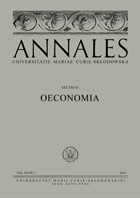The Development of Key Positions in Crises on the Example of the COVID-19 Pandemic
The Development of Key Positions in Crises on the Example of the COVID-19 Pandemic
Author(s): Joanna Tabor-BłażewiczSubject(s): Economy, Human Resources in Economy
Published by: Wydawnictwo Naukowe Uniwersytetu Marii Curie-Sklodowskiej
Keywords: COVID-19; talent; development; HRM; crisis
Summary/Abstract: Theoretical background: Talent management refers to how organizations attract, select, develop and manage talented employees. Thus, talent development is an important part of the overall process. It can be observed that there are relatively few papers focusing primarily on talent development. Meanwhile, it is a more complex and fraught activity than many HR specialist recognize, thus, it is worth paying more attention and research. Even less papers covers talent development during COVID-19 as it is a relatively new problem and research is still ongoing.Purpose of the article: The aim of the article is to present the results of research on the conduct of development processes by companies for talented employees during the COVID-19 pandemic.Research methods: For the analysis, literature studies were carried out and the quantitative study with the use of the author’s questionnaire and CATI interview was organized in October–November 2020. The research sample included 102 purposefully selected organizations.Main findings: Research indicates that organizations have been affected by the pandemic in terms of their personnel policies. They decided to take restrictions, but their degree was different for talents and other employees. The biggest restrictions affected training budgets, foreign trips and postgraduate/MBA studies. Organizations continued to run talent development programs in the pandemic, but their scope decreased. Changes in priorities were also noted – the importance of talent development before the pandemic was greater for respondents. During the pandemic, retaining talent and building their commitment came to the fore. The analysis also made comparisons with the results of author’s own studies on subprime crisis, which show that the organization’s actions in these two crisis situations have converged in many areas. In particular, it was decided to maintain developmental activities, but in exchange for more costly forms of development, talents were offered cheaper internal training, projects or job rotation. The differences include the inclusion of talent in strategic projects, “crisis headquarters”, which was observed to a large extent during the subprime crisis, but did not appear in the pandemic results. It should be emphasised that the research was carried out in two different groups, which does not authorise clear conclusions, but only allows for very preliminary reflections on the behaviour of the organization in these two situations. Research results contribute to reducing the research gap in the talent development process during pandemic or crisis.
Journal: Annales Universitatis Mariae Curie-Skłodowska, Sectio H Oeconomia
- Issue Year: LV/2021
- Issue No: 2
- Page Range: 125-134
- Page Count: 10
- Language: English

